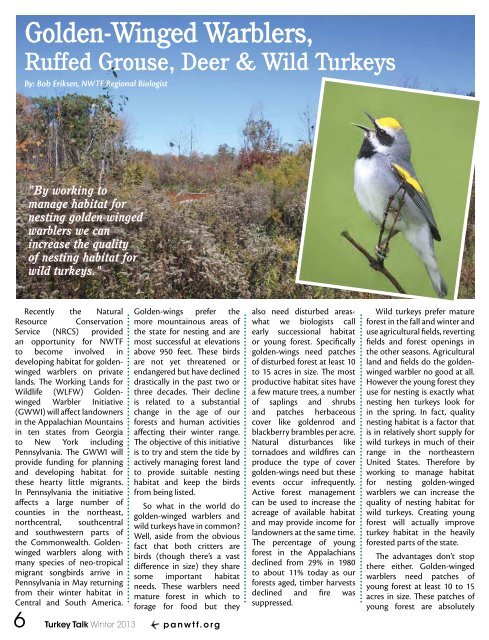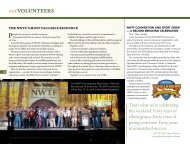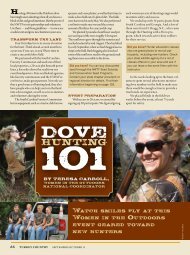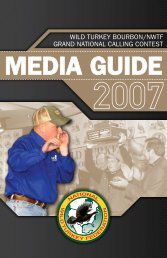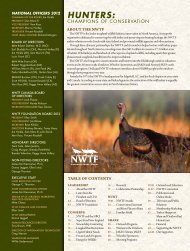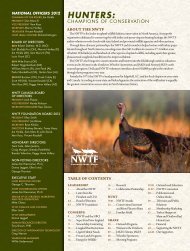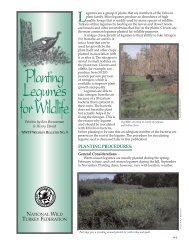Golden-Winged Warbler Initiative - National Wild Turkey Federation
Golden-Winged Warbler Initiative - National Wild Turkey Federation
Golden-Winged Warbler Initiative - National Wild Turkey Federation
You also want an ePaper? Increase the reach of your titles
YUMPU automatically turns print PDFs into web optimized ePapers that Google loves.
<strong>Golden</strong>-<strong>Winged</strong> <strong>Warbler</strong>s,<br />
Ruffed Grouse, Deer & <strong>Wild</strong> <strong>Turkey</strong>s<br />
By: Bob Eriksen, NWTF Regional Biologist<br />
"By working to<br />
manage habitat for<br />
nesting golden-winged<br />
warblers we can<br />
increase the quality<br />
of nesting habitat for<br />
wild turkeys."<br />
Recently the Natural <strong>Golden</strong>-wings prefer the<br />
Resource Conservation more mountainous areas of<br />
Service (NRCS) provided the state for nesting and are<br />
an opportunity for NWTF most successful at elevations<br />
to become involved in above 950 feet. These birds<br />
developing habitat for golden- are not yet threatened or<br />
winged warblers on private endangered but have declined<br />
lands. The Working Lands for drastically in the past two or<br />
<strong>Wild</strong>life (WLFW) <strong>Golden</strong>- three decades. Their decline<br />
winged <strong>Warbler</strong> <strong>Initiative</strong> is related to a substantial<br />
(GWWI) will affect landowners change in the age of our<br />
in the Appalachian Mountains forests and human activities<br />
in ten states from Georgia affecting their winter range.<br />
to New York including The objective of this initiative<br />
Pennsylvania. The GWWI will is to try and stem the tide by<br />
provide funding for planning actively managing forest land<br />
and developing habitat for to provide suitable nesting<br />
these hearty little migrants. habitat and keep the birds<br />
In Pennsylvania the initiative from being listed.<br />
affects a large number of<br />
So what in the world do<br />
counties in the northeast,<br />
golden-winged warblers and<br />
northcentral, southcentral<br />
wild turkeys have in common?<br />
and southwestern parts of<br />
Well, aside from the obvious<br />
the Commonwealth. <strong>Golden</strong>-<br />
fact that both critters are<br />
winged warblers along with<br />
birds (though there’s a vast<br />
many species of neo-tropical<br />
difference in size) they share<br />
migrant songbirds arrive in<br />
some important habitat<br />
Pennsylvania in May returning<br />
needs. These warblers need<br />
from their winter habitat in<br />
mature forest in which to<br />
Central and South America.<br />
forage for food but they<br />
6 <strong>Turkey</strong> Talk Winter 2013 panwtf.org<br />
also need disturbed areas-<br />
what we biologists call<br />
early successional habitat<br />
or young forest. Specifically<br />
golden-wings need patches<br />
of disturbed forest at least 10<br />
to 15 acres in size. The most<br />
productive habitat sites have<br />
a few mature trees, a number<br />
of saplings and shrubs<br />
and patches herbaceous<br />
cover like goldenrod and<br />
blackberry brambles per acre.<br />
Natural disturbances like<br />
tornadoes and wildfires can<br />
produce the type of cover<br />
golden-wings need but these<br />
events occur infrequently.<br />
Active forest management<br />
can be used to increase the<br />
acreage of available habitat<br />
and may provide income for<br />
landowners at the same time.<br />
The percentage of young<br />
forest in the Appalachians<br />
declined from 29% in 1980<br />
to about 11% today as our<br />
forests aged, timber harvests<br />
declined and fire was<br />
suppressed.<br />
<strong>Wild</strong> turkeys prefer mature<br />
forest in the fall and winter and<br />
use agricultural fields, reverting<br />
fields and forest openings in<br />
the other seasons. Agricultural<br />
land and fields do the goldenwinged<br />
warbler no good at all.<br />
However the young forest they<br />
use for nesting is exactly what<br />
nesting hen turkeys look for<br />
in the spring. In fact, quality<br />
nesting habitat is a factor that<br />
is in relatively short supply for<br />
wild turkeys in much of their<br />
range in the northeastern<br />
United States. Therefore by<br />
working to manage habitat<br />
for nesting golden-winged<br />
warblers we can increase the<br />
quality of nesting habitat for<br />
wild turkeys. Creating young<br />
forest will actually improve<br />
turkey habitat in the heavily<br />
forested parts of the state.<br />
The advantages don’t stop<br />
there either. <strong>Golden</strong>-winged<br />
warblers need patches of<br />
young forest at least 10 to 15<br />
acres in size. These patches of<br />
young forest are absolutely


